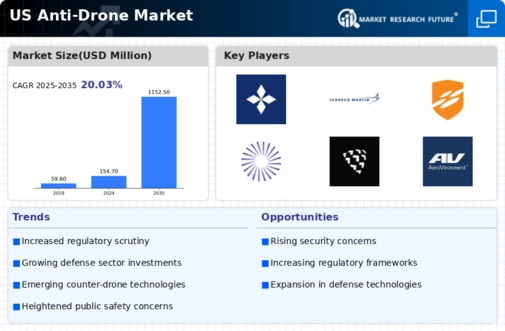Rising Security Concerns
The increasing frequency of unauthorized drone incursions into sensitive areas has heightened security concerns across various sectors. This trend is particularly evident in critical infrastructure, military installations, and public events, where the potential for malicious drone activity poses significant risks. As a result, the anti drone market is experiencing a surge in demand for effective countermeasures. According to recent estimates, the market is projected to grow at a CAGR of approximately 25% over the next five years, driven by the urgent need for enhanced security solutions. Organizations are increasingly investing in anti drone technologies to safeguard their assets and ensure public safety, thereby propelling the growth of the anti drone market.
Commercial Sector Adoption
The commercial sector's growing adoption of anti drone technologies is significantly influencing the anti drone market. Industries such as logistics, agriculture, and entertainment are increasingly recognizing the need to protect their operations from potential drone threats. For example, logistics companies are investing in anti drone systems to secure their warehouses and distribution centers from unauthorized drone surveillance or delivery. The market for commercial anti drone solutions is projected to expand rapidly, with estimates suggesting a growth rate of 30% annually. This trend indicates a shift in perception, where businesses are prioritizing security measures to safeguard their assets and maintain operational integrity. Consequently, the anti drone market is poised for substantial growth as more sectors embrace these technologies.
Public Awareness and Education
The rising public awareness regarding the risks associated with drones is contributing to the expansion of the anti drone market. As incidents of drone-related privacy violations and security breaches become more widely reported, individuals and organizations are increasingly seeking solutions to mitigate these risks. Educational campaigns and workshops are being organized to inform the public about the potential threats posed by drones and the available countermeasures. This heightened awareness is driving demand for anti drone technologies among private citizens, businesses, and local governments. As a result, the anti drone market is likely to see a diversification of its customer base, with more stakeholders recognizing the importance of investing in protective measures against drone threats.
Government Initiatives and Funding
Government initiatives aimed at enhancing national security are playing a pivotal role in the growth of the anti drone market. Federal and state agencies are increasingly allocating funds for research and development of anti drone technologies. In 2025, the U.S. government announced a $500 million investment to bolster counter-drone capabilities across various sectors, including law enforcement and defense. This funding is expected to stimulate innovation and accelerate the deployment of advanced anti drone systems. Furthermore, collaboration between government entities and private sector companies is fostering the development of tailored solutions to address specific security challenges. Such initiatives are likely to drive the anti drone market forward, creating a robust ecosystem for counter-drone technologies.
Technological Innovations in Countermeasures
The anti drone market is witnessing rapid technological advancements that enhance the effectiveness of counter-drone systems. Innovations such as advanced radar systems, electronic jamming, and drone interception technologies are becoming more prevalent. These developments not only improve detection and neutralization capabilities but also reduce response times significantly. For instance, the integration of artificial intelligence and machine learning into anti drone systems allows for real-time threat assessment and automated responses. As a result, the market is expected to reach a valuation of $3 billion by 2027, reflecting the growing reliance on sophisticated technologies to combat drone threats. This trend underscores the importance of continuous innovation within the anti drone market.






















Leave a Comment